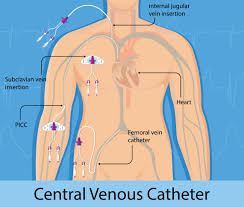A central venous catheter is a tube that is inserted into a vein in the arm or chest and ends on the right side of the heart (right atrium).
If the catheter is in your chest, it is sometimes connected to a device called a port, which is under the skin. The port and catheter are put into place through minor surgery.
The catheter helps carry nutrients and medicines into your body. It can also be used to take blood samples when you need to have blood tests. Having a port attached to the catheter will cause less wear and tear on your veins than just having the catheter.
What is the purpose of a central venous catheter and port?
Ported central venous catheters are used when you need medical treatment over a long period of time. For example, you may need:
- Antibiotics or other medications for weeks to months
- Extra nutrition because your intestines are not working properly
Or you may be receiving:
- Kidney dialysis several times a week
- Cancer drugs frequently
Your health care provider will talk with you about other methods of receiving medicine and fluids into a vein and help you decide which is best for you.
Place the port
A port is placed under the skin in minor surgery. Most ports are placed on the chest. But they can also be put on the arm.
- You may be put into a deep sleep so you won’t feel pain during surgery.
- You may stay awake and receive medicine to help you relax and numb the area so you don’t feel pain.
You can go home after the port is in place.
- You will be able to feel and see a quarter-sized lump under the skin where the port is.
- You may be slightly sore for a few days after surgery.
- Once it has healed, the port should not hurt.
Care and use of the port
The port has 3 parts:
- Portal or reservoir. A bag that is made of hard metal or plastic.
- Silicone cover. Where a needle is inserted into the portal.
- Probe or catheter It carries medicine or blood from the portal to a large vein and to the heart.
To receive medication or nutrition through the port, a trained provider will poke a special needle through the skin and the silicone cover into the portal. A numbing cream may be used on the skin to decrease pain from the needle stick.
- The port can be used at home, in a clinic, or in the hospital.
- A sterile dressing (bandage) will be placed around the port when it is used to help prevent infection.
When the port is not in use, you can bathe or swim, as long as your provider says you are ready for the activity. Check with your provider if you plan to play any contact sports, such as soccer and football.
Nothing will stick out of your skin when the port is not in use. This decreases the chance of infection in or around the port.
About once a month, you will need to have the port flushed to help prevent clots. To do this, the provider will use a special solution.
The ports can be used for a long time. When it is no longer needed, your provider will pick it up.
When to call the doctor
Tell your provider right away if you notice any signs of infection such as:
- Its port seems to have moved.
- The port site is red or there are red veins around it.
- The port site is swollen or hot.
- A yellow or green discharge is coming from the port site.
- You feel pain or discomfort at the site.
- You have a fever over 100.5ºF (38.0ºC).










